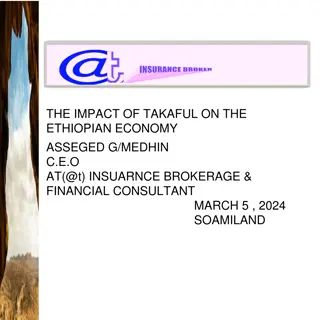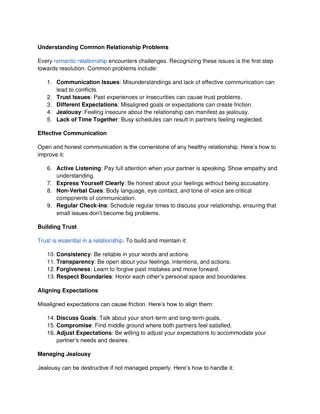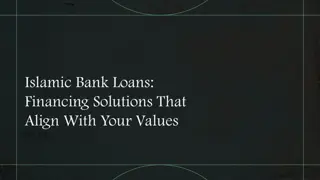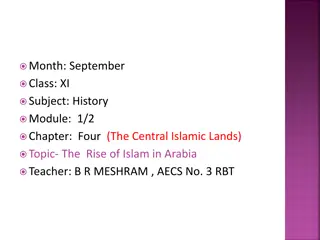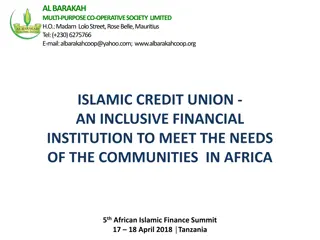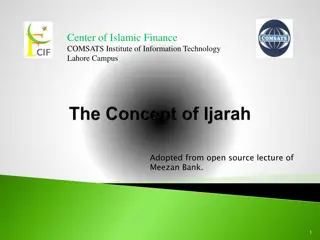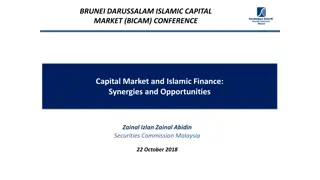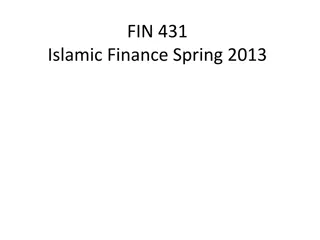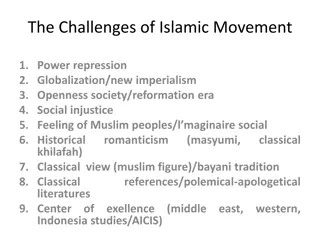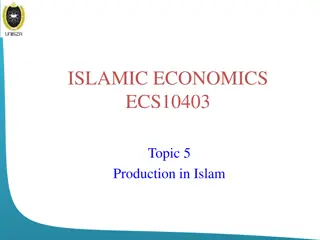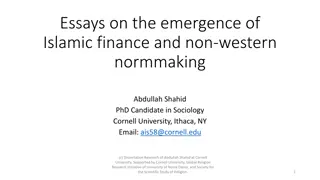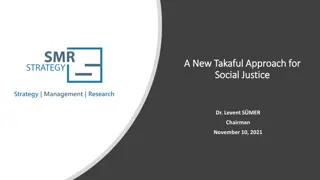Understanding Takaful: Islamic Principles and Operational Framework
Takaful, rooted in Islamic principles of mutual protection and joint guarantee, emphasizes mutuality and cooperation. It differs from conventional insurance by focusing on piety, brotherhood, and charity while promoting community well-being. This model ensures risk sharing, Sharia compliance, and surplus distribution among participants, making it a unique alternative to profit-driven insurance systems.
Download Presentation

Please find below an Image/Link to download the presentation.
The content on the website is provided AS IS for your information and personal use only. It may not be sold, licensed, or shared on other websites without obtaining consent from the author. Download presentation by click this link. If you encounter any issues during the download, it is possible that the publisher has removed the file from their server.
E N D
Presentation Transcript
Center of Islamic Finance COMSATS Institute of Information Technology Lahore Campus Adopted from open source lecture of Capt. M. Jamil Akhtar Khan Customized for best knowledge sharing. 1
Takaful comes from the Arabic root-word kafala guarantee. Takaful means mutual protection and joint guarantee. Operationally, takaful refers to participants mutually contributing to a common fund with the purpose of having mutual indemnity in the case of peril or loss. 3
Mutuality and cooperation. Takaful contract pertains to Tabarru at as against mu awadat in case of conventional insurance. Payments made with the intention of Tabarru (contribution) Eliminates the elements of Gharrar, Maisir and Riba. Wakalah/Mudarabah basis of operations. Joint Guarantee / Indemnity amongst participants shared responsibility. Constitution of separate Participants Takaful Fund . Constitution of Shariah Supervisory Board. Investments as per Shariah. 4
Piety (individual purification) Brotherhood (mutual assistance) Charity (Tabarru or contribution) Mutual Guarantee Community maximization. well-being as opposed to profit 5
Comparing Takaful to Conventional Insurance Issue Conventional Insurance Takaful Organization Principle Basis Profit for shareholders Risk Transfer Mutual for participants Co-operative risk sharing Value Proposition Profits maximization Affordability and spiritual satisfaction Sharia plus regulations Laws Secular/Regulations Ownership Shareholders Participants Management status Company Management Operator Form of Contract Contract of Sale Cooperative, Islamic contracts of Wakala or Mudarbah with Tabar ru (contributions) Investments Interest based Sharia compliant, Riba-free Surplus Shareholders account Participants account 6
The surplus is shared between the participants with a takaful operator. The sharing of such profit (surplus) may be in a ratio 5:5 , 6:4 etc. as mutually agreed between the contracting parties. Generally, these risk sharing arrangements allow the takaful operator to share in the underwriting results from operations as well as the favorable performance returns on invested premiums. 8
Profits attributable to Shareholders Mudaraba Model Mudaraba Model Company s Admin. & Mangt. Expenses Company Investment By Company Profit From Investments Company s Share from Surplus Takaful Contributio n paid by Participant General Takaful Fund General Takaful Fund Operational Cost of Takaful Surplus (Profit) Participant Participant s Share from Surplus 9
Cooperative risk sharing occurs among participants where a takaful operator earns a fee for services (as a Wakeel or Agent) and does not participate or share in any underwriting results as these belong to participants as surplus or deficit. Under the Al- Wakala model, the operator may also charge a fund management fee and performance incentive fee. 10
Wakala Model Wakala Model Mudarib's Share of PTF s Investment Income Profit From Investments Profit/Loss attributable to Shareholders Wakala Fee (30% to 35%) Management Expense of the Company Company (Capital) Takaful Contribution paid by Participant Investment by the Company Investment Income Sharing on Mudaraba Basis Operational Cost of Takaful/ ReTakaful Surplus Distribution to Participants General Takaful Fund Participants Takaful Fund Surplus (Profit) Investment Income Reserves 11
It is a WAKALAH model with a separate legal entity of WAQF in- between. The relationship of the participants and the operator is directly with the WAQF fund. The operator is the Wakeel of the fund and the participants pay contribution to the WAQF fund by way of Tabarru. The contributions received would also be a part of this fund and the combined amount will be used for investment and the profits earned would again be deposited into the same fund which also eliminates the issue of Gharar. Losses to the participant are paid by the company from the same fund. Operational expenses that are incurred for providing Takaful services are also met from the same fund. 12
Wakala- -Waqf Model Wakala Waqf Model S H A R E H O L D E R S F U N D (S.H.F.) Share Holder Mudarib s Share of PTF s Investment Income Management Expense of the Company Wakalah Fee Investmen t Income Profit/Loss Takaful Operator Investment by the Company WAQF Claims & Reserves Operational Cost of Takaful / ReTakaful Surplus (Balance) Investment Income P A R T I C I P A N T S T A K A F U L F U N D (P.T.F.) Participant 13
General Takaful offers all kinds of non-life risk coverage. It is normally divided into following classes: Property Takaful Marine Takaful Motor Takaful Miscellaneous Takaful 14
Term Life Takaful Whole Life Takaful Endowment Takaful Universal Takaful Marriage Plan Education Plan 15
97% Muslim population. Demand for insurance increasing with increase in per capita income. Personal lines insurance business (leasing, health, Medicare) growing at a higher rate than other conventional classes. Islamic banking on sound footing with support of the Govt. 16
THANK YOU 17


